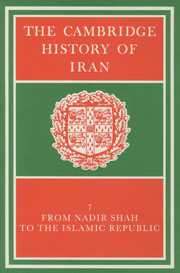Book contents
- Frontmatter
- PART 1 THE POLITICAL FRAMEWORK, 1722–1979
- PART 2 FOREIGN RELATIONS
- PART 3 ECONOMIC AND SOCIAL DEVELOPMENTS
- 13 LAND TENURE AND REVENUE ADMINISTRATION IN THE NINETEENTH CENTURY
- 14 THE TRIBES IN EIGHTEENTH- AND NINETEENTH-CENTURY IRAN
- 15 THE TRADITIONAL IRANIAN CITY IN THE QāJāR PERIOD
- 16 EUROPEAN ECONOMIC PENETRATION, 1872–1921
- 17 ECONOMIC EVELOPMENT, 1921–1979
- 18 THE IRANIAN OIL INDUSTRY
- PART 4 RELIGIOUS AND CULTURAL LIFE, 1721–1979
- Genealogical tables
- Bibliographies
- Index
- References
13 - LAND TENURE AND REVENUE ADMINISTRATION IN THE NINETEENTH CENTURY
from PART 3 - ECONOMIC AND SOCIAL DEVELOPMENTS
Published online by Cambridge University Press: 28 March 2008
- Frontmatter
- PART 1 THE POLITICAL FRAMEWORK, 1722–1979
- PART 2 FOREIGN RELATIONS
- PART 3 ECONOMIC AND SOCIAL DEVELOPMENTS
- 13 LAND TENURE AND REVENUE ADMINISTRATION IN THE NINETEENTH CENTURY
- 14 THE TRIBES IN EIGHTEENTH- AND NINETEENTH-CENTURY IRAN
- 15 THE TRADITIONAL IRANIAN CITY IN THE QāJāR PERIOD
- 16 EUROPEAN ECONOMIC PENETRATION, 1872–1921
- 17 ECONOMIC EVELOPMENT, 1921–1979
- 18 THE IRANIAN OIL INDUSTRY
- PART 4 RELIGIOUS AND CULTURAL LIFE, 1721–1979
- Genealogical tables
- Bibliographies
- Index
- References
Summary
The Qājār land system was inherited from the Safavids and goes back through the Īlkhāns and Saljūqs to the early centuries of Islam. The earlier systems had resulted from the historical incidents of conquest and had been moulded by local custom and the theory of the sharī'a. This was also to some extent true of the Qājār system, but though there was a correspondence between it and the earlier systems there was not necessarily identity between them. Although abuses similar to those found in Western European feudalism, such as the existence of private armies and the subjection of the peasantry, were associated with the Qājār land system, and although there was a close connection between the revenue assessment and the levy of troops, it was not, in the technical sense, a feudal system, and nor had it developed out of a feudal system. It is to be seen not only in relation to the idea of property but also against the background of demographic movements and economic change.
The urban life and extensive commerce which had developed under the Safavids had been severely damaged by the disorders which had followed the fall of that dynasty. Agriculture suffered from the general recession of the eighteenth century and was probably also adversely affected by the depopulation which occurred in some parts of the country at the time of the Afghan invasion and in the latter years of Nādir Shāh. The nineteenth century witnessed a reversal of these trends, but the revival was not uniform throughout the country or throughout the century. Lack of communications continued to impede the movement of goods and to accentuate regional isolation.
- Type
- Chapter
- Information
- The Cambridge History of Iran , pp. 457 - 505Publisher: Cambridge University PressPrint publication year: 1991

